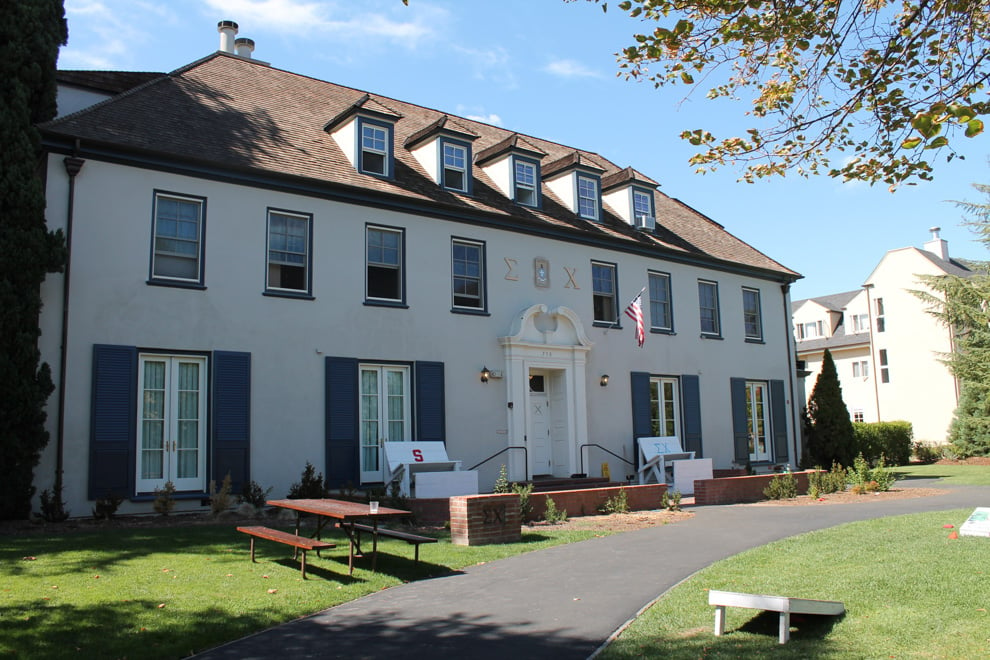Reid Spitz received his B.S. in symbolic systems in 2014 and his M.A. in philosophy in 2016. He co-founded an insurtech startup and now lives in Miami, Fla. Ned Chambers received his B.S. in human biology in 1973. He recently retired from a neighborhood family medical practice in San Diego. Neither belonged to a housed fraternity while at Stanford.
In her opinion piece published Apr. 27, former undergraduate Alex Young (a founding member of Abolish Stanford Greek) questions why only Greek organizations deserve campus housing over what she contends are 650+ open membership clubs on campus. Her suggestion is that because members of these other organizations do not have the option to stay multiple years in their residences, nobody should have that option. We argue that instead of ending this option for the fewer than 500 students who now benefit, it should be expanded to all students.
Acknowledging a housing shortage, the original row houses were built by Greek alumni to meet a severe housing shortage for undergraduates. In response, alumni raised what would be tens of millions in today’s dollars to assist the University in housing undergraduates. The organizations that did so raised funds that both increased the undergraduate housing supply and allowed the organization’s students to be housed.
In the 1960s, Greek alumni were approached again and encouraged to abandon their Row houses to build even more student housing on the Knoll and by Lake Lagunita. They were once again asked to be the principal funders of new undergraduate housing. One group, Sigma Chi (550 Lasuen), rejected the offer, but continues to maintain their own property under a lease with the University, paying a 6-figure ground lease rent and performed a multi-million dollar renovation in 2006.
Ms. Young’s proposed solution to what she perceives as an inequity is the opposite of what ought to be University policy. The real solution here is not taking away the option of multi-year housing from the fewer than 500 students in those residences; it is offering that type of housing to all students who want it.
While Ms. Young cites statistics that are several years old, this spring’s rush tells us how dramatically undergraduate housing demand has increased in the years since Ms. Young was an undergraduate. As one example, over 435 Stanford men rushed fraternities this year, according to our conversations with the IFC. Only about 200 received bids. We estimate that less than half of them will be able to live in a Greek residence next year.
Sorority rush this spring saw similar numbers. 396 students rushed sororities; 254 received bids. Demand was also way up for students rushing groups in the Multicultural Greek Council (MGC) and African-American Fraternal & Sororal Association (AAFSA). Given strong demand, the University should find ways to add more Greek housing options rather than removing existing housing.
Approximately a thousand students (versus a freshman class of 2,350) wanted to join Greek lettered organizations this spring. The housed Greek organizations draw the greatest interest. These students likely want to live in multi-year housing largely to develop the closer relationships and lifetime bonds created in such an environment.
Based on our assessment of housing capacity, we estimate that the 10 houses now assigned to Greek organizations can hold just under 500 students. This spring’s rush suggests that there’s demand for Greek housing by as many as 3300 students, given a spring rush of 831 multiplied by four class years. A more conservative estimate might put this number around 2500 — still five times the available supply.
Ms. Young contends that this dynamic is unfair. What she does not share, and presumably does not know, is that it is Greek alumni who for at least 15 years have lobbied the University to dramatically expand this housing option to all students. Given the lack of similar housing options for non-Greek students, it is evidently the Office of Student Affairs that stubbornly resists doing so. The University should be meeting demand by either increasing the supply of Greek residences or letting all other student organizations and students have an opportunity to live in an expanded pool of similar residences.
Instead of placing blame with the Office of Student Affairs, Ms. Young contends there is “only one explanation for all this: donor influence.” She claims it is “well known that Greek alumni donate more to their universities than non-Greek alumni.” She asserts that Greek alumni tend to be the “wealthiest and the most powerful alumni.”
Whether Ms. Young’s claim that the University’s most successful alumni are Greek is accurate or not, it is undisputed that Greek alumni do contribute significantly more at most schools, including Stanford. There is a reason. Ms. Young’s linked documents establish that students in Greek life are more likely to say they formed relationships with mentors and professors, were more active in extracurricular activities and had better access to internships. All of these positive outcomes are the necessary by-product of the relationships and lifetime bonds that are created by living with a diverse group of roughly 50 individuals from different class years for multiple years in the same Stanford residence.
Alumni who strongly bond with their university as a student will be more bonded as an alum. They volunteer more. They give more. Stanford would do a service to all its students (and its endowment) by dramatically increasing the housing stock devoted to multi-year living options for all students and organizations. Let supply rise to meet the overwhelming demand.
Stanford has formed a new task force to see how to restore fun to the campus. One solution is to make everybody happy with their housing options, instead of making everyone equally unhappy as Ms. Young proposes.
